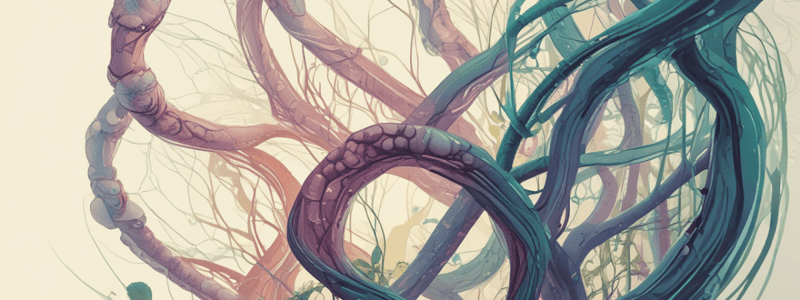Podcast
Questions and Answers
What is the study of interactions between organisms and their environment?
What is the study of interactions between organisms and their environment?
- Ecology (correct)
- Biochemistry
- Genetics
- Botany
What is the basic unit of life?
What is the basic unit of life?
- Molecule
- Tissue
- Cell (correct)
- Organelle
What is the study of heredity and variation?
What is the study of heredity and variation?
- Microbiology
- Genetics (correct)
- Biochemistry
- Molecular Biology
What is the biosphere?
What is the biosphere?
What type of biological molecule provides energy and structural components?
What type of biological molecule provides energy and structural components?
What is the level of organization that consists of groups of organs working together?
What is the level of organization that consists of groups of organs working together?
Flashcards are hidden until you start studying
Study Notes
Biology Definition
- Biology is the scientific study of life and living organisms, including their structure, function, growth, evolution, distribution, and taxonomy.
Branches of Biology
- Botany: study of plants
- Zoology: study of animals
- Microbiology: study of microorganisms
- Ecology: study of interactions between organisms and their environment
- Genetics: study of heredity and variation
- Biochemistry: study of chemical processes in living organisms
- Molecular Biology: study of biological processes at the molecular level
Levels of Organization
- Molecules: building blocks of life (e.g. DNA, proteins, carbohydrates)
- Organelles: specialized structures within cells (e.g. mitochondria, chloroplasts)
- Cells: basic units of life
- Tissues: groups of similar cells performing a specific function
- Organs: structures composed of two or more types of tissues
- Organ Systems: groups of organs working together to maintain homeostasis
- Organisms: individual living things
- Populations: groups of organisms of the same species
- Communities: groups of different species interacting in an ecosystem
- Ecosystems: communities and their physical environment
- Biosphere: all ecosystems on Earth
Biological Molecules
- Carbohydrates: energy source, structural components (e.g. glucose, cellulose)
- Proteins: structural, functional, and regulatory roles (e.g. enzymes, hormones)
- Lipids: energy storage, structural components (e.g. fats, phospholipids)
- Nucleic Acids: genetic information (e.g. DNA, RNA)
Cell Biology
- Cell Membrane: semi-permeable membrane separating cell from environment
- Cellular Organelles: mitochondria (energy production), ribosomes (protein synthesis), lysosomes (waste management)
- Cell Cycle: stages of cell growth, replication, and division
- Mitosis: process of cell division resulting in two identical daughter cells
- Meiosis: process of cell division resulting in four non-identical daughter cells (gametes)
Evolution
- Theory of Evolution: gradual change in species over time through natural selection
- Mechanisms of Evolution: mutation, genetic drift, gene flow, selection
- Evidence for Evolution: fossil record, comparative anatomy, molecular biology
Biology Definition
- Biology is the scientific study of life and living organisms, examining their structure, function, growth, evolution, distribution, and taxonomy.
Branches of Biology
- Botany studies plants and their interactions.
- Zoology focuses on animals and their interactions.
- Microbiology explores microorganisms and their interactions.
- Ecology examines the interactions between organisms and their environment.
- Genetics delves into heredity and variation.
- Biochemistry analyzes the chemical processes in living organisms.
- Molecular Biology probes biological processes at the molecular level.
Levels of Organization
- Molecules are the building blocks of life, including DNA, proteins, and carbohydrates.
- Organelles are specialized structures within cells, such as mitochondria and chloroplasts.
- Cells are the basic units of life.
- Tissues are groups of similar cells performing a specific function.
- Organs are structures composed of two or more types of tissues.
- Organ Systems are groups of organs working together to maintain homeostasis.
- Organisms are individual living things.
- Populations are groups of organisms of the same species.
- Communities are groups of different species interacting in an ecosystem.
- Ecosystems consist of communities and their physical environment.
- The Biosphere encompasses all ecosystems on Earth.
Biological Molecules
- Carbohydrates serve as energy sources and structural components, including glucose and cellulose.
- Proteins have structural, functional, and regulatory roles, such as enzymes and hormones.
- Lipids function in energy storage and as structural components, including fats and phospholipids.
- Nucleic Acids contain genetic information, comprising DNA and RNA.
Cell Biology
- The Cell Membrane is a semi-permeable membrane separating the cell from its environment.
- Cellular Organelles include mitochondria for energy production, ribosomes for protein synthesis, and lysosomes for waste management.
- The Cell Cycle consists of stages of cell growth, replication, and division.
- Mitosis is the process of cell division resulting in two identical daughter cells.
- Meiosis is the process of cell division resulting in four non-identical daughter cells (gametes).
Evolution
- The Theory of Evolution posits that species undergo gradual change over time through natural selection.
- Mechanisms of Evolution include mutation, genetic drift, gene flow, and selection.
- Evidence for Evolution is found in the fossil record, comparative anatomy, and molecular biology.
Studying That Suits You
Use AI to generate personalized quizzes and flashcards to suit your learning preferences.



